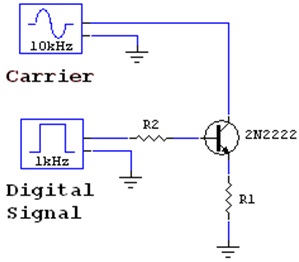The simplest and most common form of amplitude Shift Keying operates as a switch using the presence of a carrier wave to indicate a binary one and its carrier wave to indicate a binary zero. This type of modulation is called On-Off keying.
In ASK logic levels are represented by different amplitudes of signals. Usually one amplitude is zero for logic digital zero while logic 1 represented by the actual amplitude of some sine wave.
 |
In the above circuit the transistor is using as switch for performing the operation of on and OFF. When the data is 1 of modulating digital signal, sine wave is switched to output because sine wave is using as carrier signal, and when the data is 0, the transistor is disabled to produce the sinewave.







